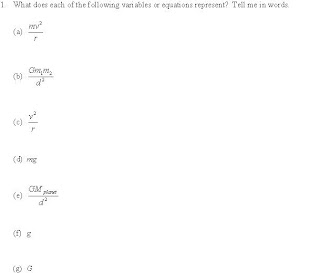 |
| Don't get eaten when you have to give a C. |
I haven't posted in a week 'cause grades and comments were due today. And when I say "comments," I don't mean checking a box that says "He's a nice, hard working boy." I mean a 3-30 sentence narrative discussing each of my 57 college-level physics students.
This year, more students than ever took my
Honors Physics I course. Of my 49 students in that class, 30 earned A's for the first marking period... that's far more than I'm used to. The Honors Physics approach that emphasizes verbal explanations has been working well.
However, 10 students earned C's, and one earned a D. Usually I have only one or two C's in the first marking period, and none for the full year; I haven't given a D in this course, even for a marking period, in a decade. None of my students is misplaced in honors; all seem intellectually capable of handling the material. I'm thinking that the expanded numbers in the course gave me more students who are, for now, unwilling to adapt to the deep thinking that is required on every problem set and every test.
Now, the political atmosphere surrounding grades is different at every school. At Woodberry, no one is going to complain when I give a C or a D. However, if I want to avoid an awkward or hostile conversation with advisors, parents, and the department chair, I'd better provide unambiguous narrative support for the grade; and, I'd better be able to show that I've made attempts to help each student raise his* grade. Just "he's not working hard enough on his homework" doesn't cut it, even if that's the nuts-and-bolts truth of the matter.
* I teach at a boys' school -- this pronoun usage is deliberate and accurate.
My grade calculation weighs homework and test performance heavily, to the tune of 85% of the overall grade. But parents don't want to hear about poor homework performance. They believe their son when he says it's too tough and too time consuming, because they see him frustrated while doing the homework every night. Parents don't want to hear about poor test performance. They believe their son that "no one" did well, and that the teacher never went over the type of problems that were on the test, because that's likely consistent with their own physics experience two decades ago. Parents don't expect students to get C's just because the subject matter is difficult.
We as teachers know that the actual reason this guy got frustrated on his homework every night is that he never listened in class, never asked a friend for help, never kept working after an initial 15 minutes, no matter how many times we suggested these things might be a good idea. We know the reason he did poorly on the test is that he didn't get enough serious problem solving practice on the homework. But when our honest evaluation goes head-to-head with a student's plausible excuses, parents will invariably side against us. How can we convince parents and colleagues that (in my friend Pete's words) we are merely the publisher, not the author, of a bad grade?
Understand that performance on my first test was good. I initially graded it on an approximate AP-style scale: 27 students earned 5s, 11 earned 4s, 9 earned 3s, with a single 2. I'm pleased with that distribution... but even though a 3 on the AP exam is "passing," it also means only about 35%-50% of the answers were right. I make students correct their tests to get the right answer, and I give half credit back for the corrections.
This year, I had more students than ever who did a half-arsed job on the corrections. They repeated the same mistakes; tried to justify their answers with "common sense;" or just left several corrections blank. Well, they didn't get much credit back... and as a result, a test that should have produced virtually all As and Bs put ten students in the C and D range.
Interestingly, but not surprisingly, virtually all of those who did a poor job correcting their test also had very bad scores on our weekly
fundamentals quizzes. These quizzes don't test problem solving skills, they test memorization of facts.
So in my comments, I didn't refer exclusively to poor homework and test performance. In fact, I was invariably upbeat about test performance: "Will earned a 3 on our first AP-style practice test, and I have confidence that he can improve to a 4 or higher eventually this year." But then I dropped the hammer, with specific reference to an undisputed fact: "Will had the opportunity to correct the test problems that he missed. With diligent corrections, he could have earned a B for the test. However, most of his corrections consisted of mere guesswork, and some were even blank. He earned only 2 of 15 possible corrections points, and his test score became a D+."
In a similar vein, I cited a student's scores on fundamentals quizzes, emphasizing that performance on these is a matter of recall rather than synthesis. I exhorted the student to prepare more diligently for fundamentals quizzes, and reminded him that memorization of facts is a precursor to success in any academic class, not merely physics.
The above is not to say that every parent, colleague, and student will be placated after seeing a C on the transcript. I also have to calmly explain that it's still early in the course, there's plenty of time to improve, and so on. I'm merely offering the observation that it's worth providing the opportunity to correct a difficult test, worth providing the opportunity for a student to improve his grade through a memorization quiz. These are useful exercises pedagogically, certainly; but these also help back the lazy or ill-prepared student into a corner when he tries to make excuses for poor performance.
What happens next? Very often, the student with a C makes a serious effort on fundamentals quizzes and does a much better job correcting the next test. Then he finds that the homework isn't quite as tough anymore, because he knows the basic facts. Then, because he's taken a step to engaging with the material, he finds his performance on the trimester exam to be pretty danged good. Amazing.














